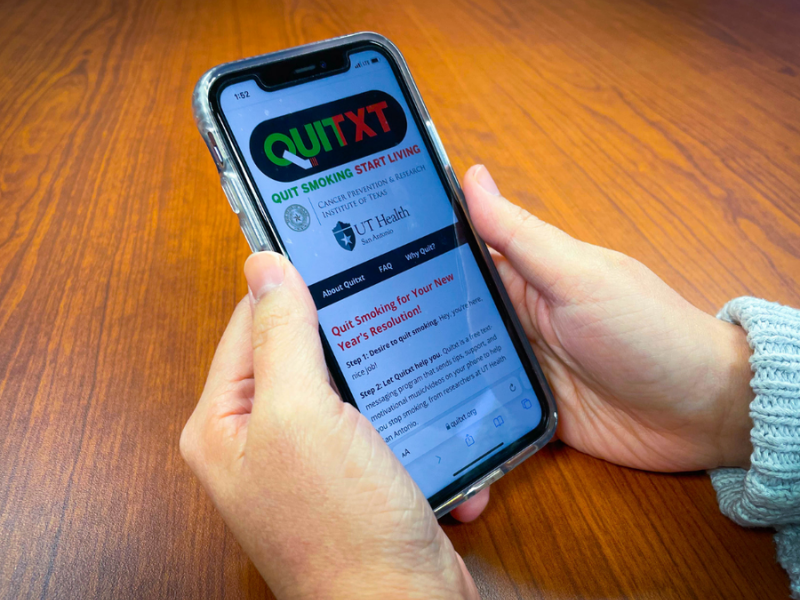
Share On Social!
In the bar or club, it’s easy to find people smoking and drinking.
What would happen if health workers walked into these venues to ask cigarette smokers — face to face — to join a quit-smoking service on their phone?
To find out, UT Health San Antonio researchers and an ad agency trained “street teams” to go into bars and clubs in San Antonio, Texas, to talk to patrons about joining Quitxt, a bilingual service that uses text messages to help young Latino adults quit smoking.
Street teams talked with 3,923 people and enrolled 335 to Quitxt over 10 days in March 2020 before the COVID-19 pandemic halted work, according to a new study in the journal JMIR Formative Research.
“Direct outreach in bars and clubs is a useful method for connecting young adult cigarette smokers with mobile cessation services,” said Dr. Amelie G. Ramirez, study leader and director of Salud America! at the Institute for Health Promotion Research at UT Health San Antonio.
Why Did the Study Seek to Enter Bars and Clubs to Recruit for Quitxt?
Smoking and drinking alcohol are concomitant behaviors.
But few studies have explored recruiting smokers into mobile cessation services at bars, clubs, and other places where alcohol is regularly served.
 So Ramirez and her team — including Dr. Patricia Chalela, associate professor of population health sciences at UT Health San Antonio — designed a study to enter bars and clubs for face-to-face recruitment to their Quitxt text-message service.
So Ramirez and her team — including Dr. Patricia Chalela, associate professor of population health sciences at UT Health San Antonio — designed a study to enter bars and clubs for face-to-face recruitment to their Quitxt text-message service.
Quitxt, funded by the Cancer Prevention and Research Institute of Texas since 2015, is culturally and linguistically designed for Latino adults ages 18-29.
“Adapting recruitment strategies to expand the reach of programs like Quitxt to where smokers are located may help decrease the health-equity gap in tobacco control by improving reach and enrollment of underserved smokers residing in low-income and rural areas who are not reached by traditional cessation services,” Chalela said.
How Did the Study Conduct Recruitment to Quitxt in Bars and Clubs?
For the study, Ramirez and Chalela partnered with with Foundry512, an ad agency based in Austin, Texas.
Jesus Trujillo of Foundry512 led the recruitment and training of nine part-time, bilingual workers. These would form the street teams to enter bars and clubs and engage patrons.
Street team learned about public health impacts of cigarette smoking, project aims, and did mock interactions with patrons.
 “With the support of our research team, Foundry512 prepared the teams with for questions or doubts that smokers may have during the interactions, using empathetic approaches and responses that reflect the challenge of quitting, and learning ways to handle difficult situations or extremely negative responses,” Chalela said.
“With the support of our research team, Foundry512 prepared the teams with for questions or doubts that smokers may have during the interactions, using empathetic approaches and responses that reflect the challenge of quitting, and learning ways to handle difficult situations or extremely negative responses,” Chalela said.
Between March 8-18, 2020, street teams entered 25 bars, clubs, and other venues frequented by young smokers in urban San Antonio and nearby rural areas.
They asked patrons three questions:
- How important is it to you to quit smoking?
- How confident are you in your ability to quit smoking?
- How ready do you feel to quit smoking?
“In each interaction, street teams first established rapport with the smokers and eventually introduced the Quitxt mobile smoking cessation program, explained its functions and benefits, and invited them to join the program,” Chalela said.
How Much Success Did the Study Have in Recruiting Smokers to Join Quitxt?
Study street teams interacted with 3,923 people in bars and clubs.
Of those, 335 (8.5%) enrolled in Quitxt. Most participants were Latino and spoke English. Their mean age was 29 and they smoked a mean of 8.5 cigarettes per day.
 Among users ready to make a quit attempt, 22% texted they had one tobacco-free day. 16% texted they achieved one week without smoking.
Among users ready to make a quit attempt, 22% texted they had one tobacco-free day. 16% texted they achieved one week without smoking.
The response rate to later follow-up text questions was low.
“We need to learn more about how mobile services can influence long-term smoking cessation among those recruited through direct outreach, as well as to test the use of incentives in obtaining more useful response rates,” Ramirez said.
Chalela added the study results showed promise.
“Young adults are less likely to seek or use traditional cessation services, such as quitlines. Direct outreach to young adult smokers by street teams of peers may improve reach and enrollment to smoking cessation services. This is particularly if the program is tailored to the participants’ culture, language, and media use,” Chalela said.
Do You Want to Quit Smoking?
If you are interested in quitting cigarettes, join Quitxt.
Quitxt sends messages and support via phone texts to help South Texas young adults quit smoking. Messages help with motivation to quit, setting a quit date, handling stress, and using nicotine replacement, if needed.
To join in English, text “iquit” to 844-332-2058.
For Spanish, text “lodejo” to 844-332-2058.
“Quitting smoking is a big health boost. Within minutes, your heart returns to normal resting rate, blood circulation improves, and blood pressure drops,” Ramirez said. “After a few days, healthy cells replace damaged ones in the lungs. Quitting also reduces your risk of cancer and disease over time.”
By The Numbers
142
Percent
Expected rise in Latino cancer cases in coming years



